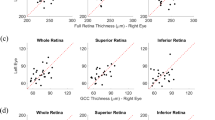Abstract
Purpose
To compare the diagnostic assessment of glaucoma specialists with an automated structure–function correlation report combining visual field (VF) and spectral-domain optical coherence tomography (SD-OCT) imagining in subjects with glaucoma.
Methods
This prospective, cross-sectional study was conducted at Wills Eye Hospital, Philadelphia, PA, USA. Subjects with glaucoma received ophthalmic examination, VF testing, and SD-OCT imaging. An automated report was generated describing structure–function correlations between the two structural elements [retinal nerve fiber layer (RNFL) and Bruch’s membrane opening-minimum rim width (MRW)] and VF sectors. Three glaucoma specialists masked to the automated report and to each other identified clinically significant structure–function correlations between the VF and SD-OCT reports. Raw agreement and chance-corrected agreement (kappa statistics) between the automated report and the clinical assessments were compared.
Results
A total of 53 eyes from 45 subjects with glaucoma were included in this study. The overall agreement between the automated report and clinical assessment comparing MRW and VF was good at 74.8% with a kappa of 0.62 (95% CI 0.55–0.69). Agreements for the six different MRW sections were moderate to good with kappa values ranging from 0.54 to 0.69. For mean RNFL thickness and VF comparisons, agreement between the automated report and clinical assessment was 75.4% with a kappa of 0.62 (95% CI 0.54–0.70). For different RNFL sectors, kappa values ranged from 0.47 (moderate agreement) to 0.80 (good agreement).
Conclusions
This study suggests that the automated structure–function report combining results from the SD-OCT and the HEP may assist in the evaluation and management of glaucoma.



Similar content being viewed by others
References
Medeiros FA, Lisboa R, Weinreb RN et al (2012) A combined index of structure and function for staging glaucomatous damage. Arch Ophthalmol 130(9):1107–1116
Tatham AJ, Weinreb RN, Zangwill LM et al (2013) Estimated retinal ganglion cell counts in glaucomatous eyes with localized retinal nerve fiber layer defects. Am J Ophthalmol 156(3):578–587 e571
Lopez-Pena MJ, Ferreras A, Larrosa JM et al (2011) Relationship between standard automated perimetry and retinal nerve fiber layer parameters obtained with optical coherence tomography. J Glaucoma 20(7):422–432
Bowd C, Zangwill LM, Medeiros FA et al (2006) Structure–function relationships using confocal scanning laser ophthalmoscopy, optical coherence tomography, and scanning laser polarimetry. Invest Ophthalmol Vis Sci 47(7):2889–2895
Leite MT, Zangwill LM, Weinreb RN et al (2012) Structure–function relationships using the Cirrus spectral domain optical coherence tomograph and standard automated perimetry. J Glaucoma 21(1):49–54
Rao HL, Zangwill LM, Weinreb RN et al (2011) Structure–function relationship in glaucoma using spectral-domain optical coherence tomography. Arch Ophthalmol 129(7):864–871
Chauhan BC, Burgoyne CF (2013) From clinical examination of the optic disc to clinical assessment of the optic nerve head: a paradigm change. Am J Ophthalmol 156(2):218–227 e212
Belghith A, Bowd C, Medeiros FA et al (2016) Does the location of Bruch’s membrane opening change over time? Longitudinal analysis using San Diego automated layer segmentation algorithm (SALSA). Invest Ophthalmol Vis Sci 57(2):675–682
Reis AS, O’Leary N, Yang H et al (2012) Influence of clinically invisible, but optical coherence tomography detected, optic disc margin anatomy on neuroretinal rim evaluation. Invest Ophthalmol Vis Sci 53(4):1852–1860
Danthurebandara VM, Sharpe GP, Hutchison DM et al (2015) Enhanced structure–function relationship in glaucoma with an anatomically and geometrically accurate neuroretinal rim measurement. Invest Ophthalmol Vis Sci 56(1):98–105
Chauhan BC, O’Leary N, Almobarak FA et al (2013) Enhanced detection of open-angle glaucoma with an anatomically accurate optical coherence tomography-derived neuroretinal rim parameter. Ophthalmology 120(3):535–543
Pollet-Villard F, Chiquet C, Romanet JP et al (2014) Structure–function relationships with spectral-domain optical coherence tomography retinal nerve fiber layer and optic nerve head measurements. Invest Ophthalmol Vis Sci 55(5):2953–2962
Malik R, Belliveau AC, Sharpe GP et al (2016) Diagnostic accuracy of optical coherence tomography and scanning laser tomography for identifying glaucoma in myopic eyes. Ophthalmology 123:1181–1189
Garway-Heath DF, Poinoosawmy D, Fitzke FW et al (2000) Map** the visual field to the optic disc in normal tension glaucoma eyes. Ophthalmology 107(10):1809–1815
Strouthidis NG, Vinciotti V, Tucker AJ et al (2006) Structure and function in glaucoma: the relationship between a functional visual field map and an anatomic retinal map. Investig Ophthalmol Vis Sci 47(12):5356–5362
Ballae Ganeshrao S, Turpin A, Denniss J et al (2015) Enhancing structure–function correlations in glaucoma with customized spatial map**. Ophthalmology 122(8):1695–1705
Altman D (1991) Practical statistics for medical research. Chapman and Hall, London
Katz J (1988) Two eyes of one? The data analyst’s dilemma. Ophthalmic Surg 19(8):585–589
Kanamori A, Naka M, Nagai-Kusuhara A et al (2008) Regional relationship between retinal nerve fiber layer thickness and corresponding visual field sensitivity in glaucomatous eyes. Arch Ophthalmol 126(11):1500–1506
Wu H, de Boer JF, Chen TC (2012) Diagnostic capability of spectral-domain optical coherence tomography for glaucoma. Am J Ophthalmol 153(5):815–826 e812
Sehi M, Zhang X, Greenfield DS et al (2013) Retinal nerve fiber layer atrophy is associated with visual field loss over time in glaucoma suspect and glaucomatous eyes. Am J Ophthalmol 155(1):73–82 e71
He L, Yang H, Gardiner SK et al (2014) Longitudinal detection of optic nerve head changes by spectral domain optical coherence tomography in early experimental glaucoma. Investig Ophthalmol Vis Sci 55(1):574–586
Acknowledgements
This study was made possible in part by the Wills Eye Innovation Grant No. WEF15064. Heidelberg Engineering provided the Optical Coherence Tomography and Visual Field testing platforms used in this study.
Author information
Authors and Affiliations
Corresponding author
Ethics declarations
Conflict of interest
The authors declare that they have no conflict of interest.
Ethical approval
All procedures performed in studies involving human participants were in accordance with the ethical standards of the institutional and/or national research committee and with the 1964 Helsinki declaration and its later amendments or comparable ethical standards.
Informed consent
Informed consent was obtained from all individual participants included in the study.
Rights and permissions
About this article
Cite this article
Cui, Q.N., Fudemberg, S.J., Resende, A.F. et al. Validation of the structure–function correlation report from the heidelberg edge perimeter and spectral-domain optical coherence tomography. Int Ophthalmol 39, 533–540 (2019). https://doi.org/10.1007/s10792-018-0836-z
Received:
Accepted:
Published:
Issue Date:
DOI: https://doi.org/10.1007/s10792-018-0836-z




